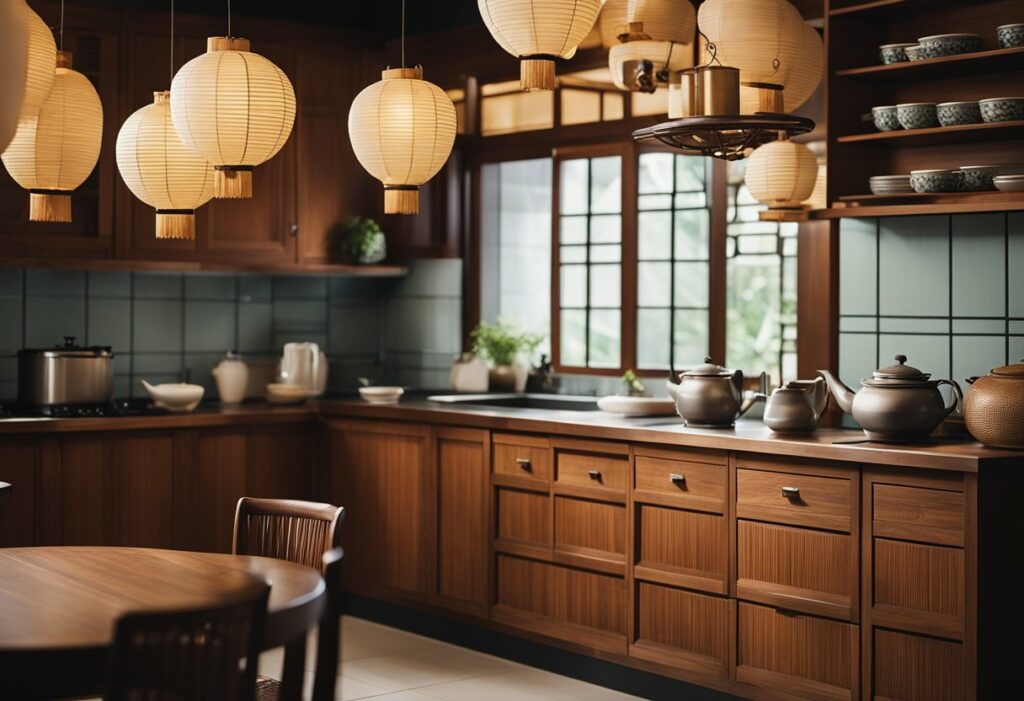Asian Kitchen Design: Bringing the Flavours of the East to Your Home
Asian kitchen design is an exciting and unique way to transform your kitchen into a beautiful and functional space. With clean lines, efficient designs, and rich wood tones, Asian kitchens look luxurious as well as unique. If you’re looking for a way to add a touch of Asian style to your home, then an Asian kitchen design is the perfect way to do it.
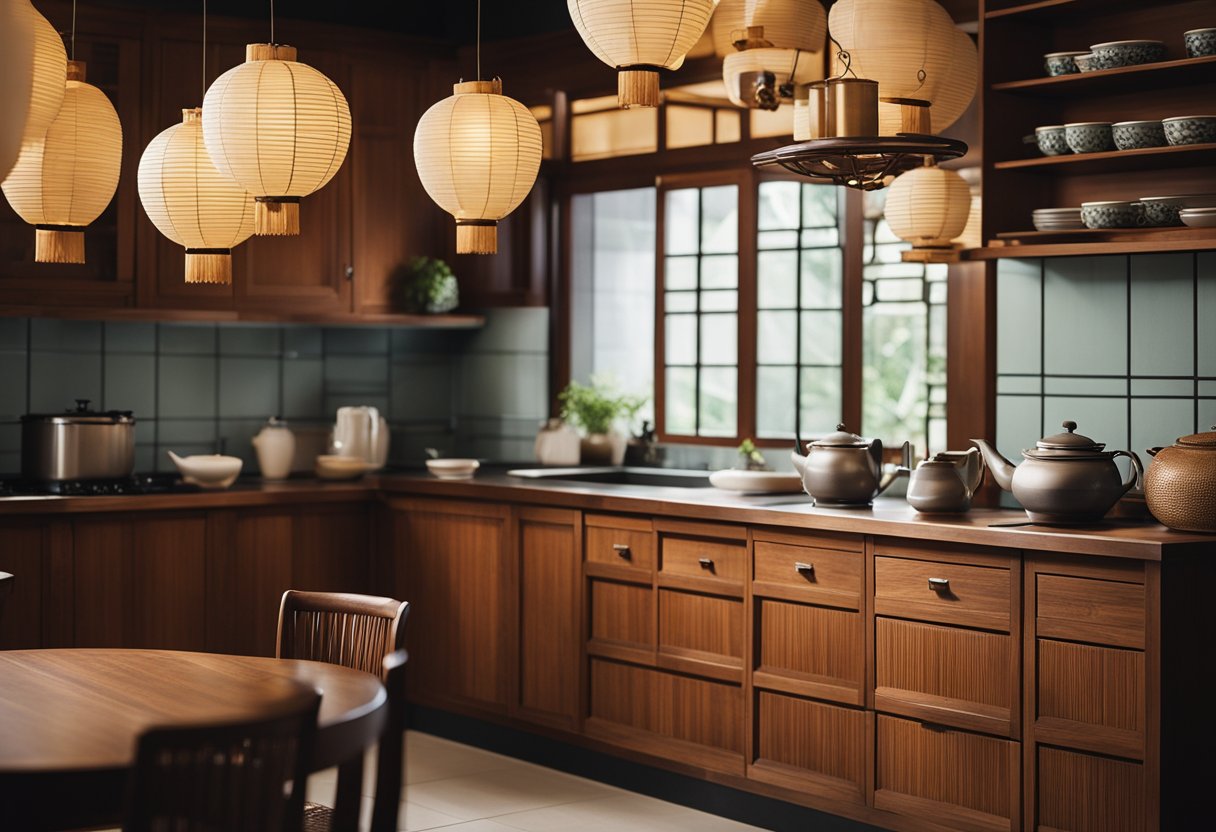
Designing your Asian-inspired kitchen requires careful consideration of the functional elements of Asian kitchen design. This includes everything from the layout and organization of your space to the materials and finishes you choose. With the right design ideas, you can create a kitchen that is not only beautiful but also highly functional and efficient. Whether you’re looking for a traditional or modern Asian kitchen design, there are plenty of options to choose from.
Key Takeaways
- Asian kitchen design is a unique and exciting way to transform your kitchen into a beautiful and functional space.
- Designing your Asian-inspired kitchen requires careful consideration of the functional elements of Asian kitchen design.
- With the right design ideas, you can create a kitchen that is not only beautiful but also highly functional and efficient.
Designing Your Asian-Inspired Kitchen
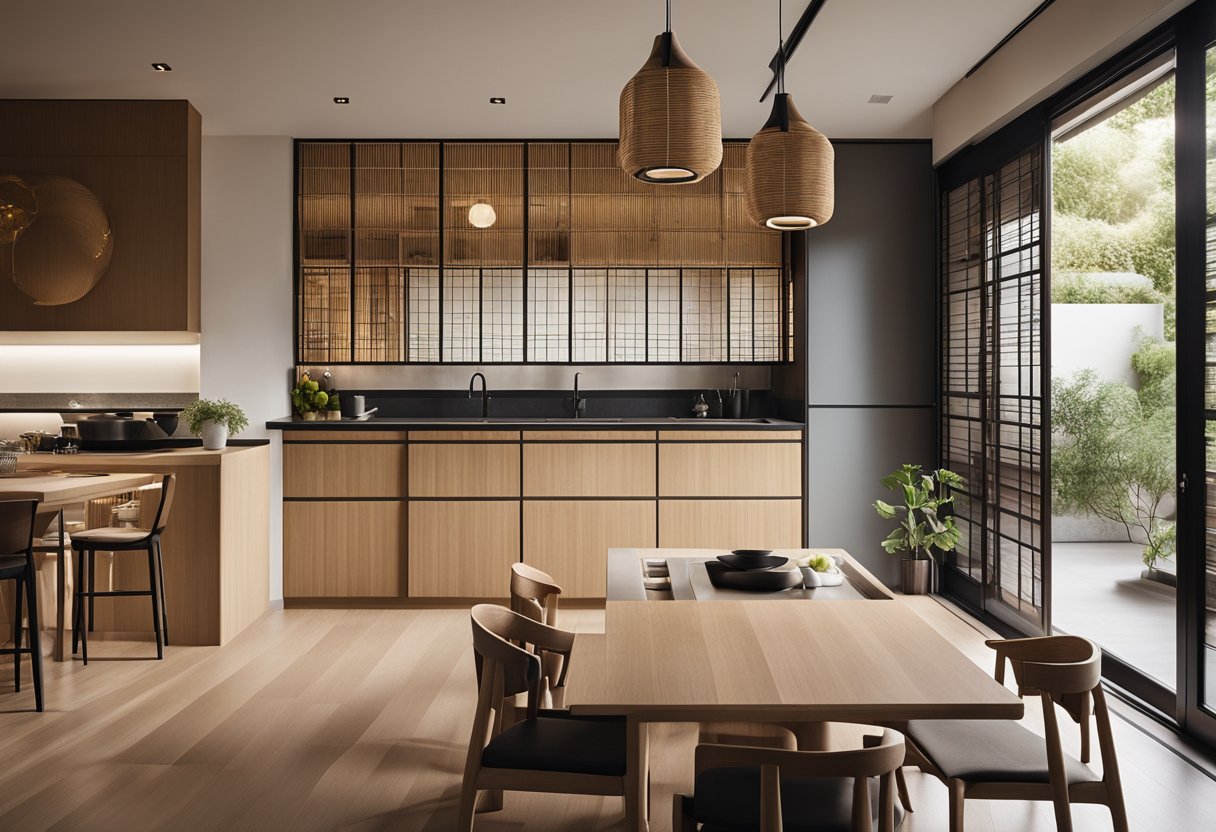
Designing an Asian-inspired kitchen can be an exciting and rewarding experience. Asian kitchens are known for their unique blend of form, balance, and functionality. In this section, we will explore the fundamentals of Asian kitchen aesthetics and provide tips on choosing the right materials and incorporating natural elements into your design.
Fundamentals of Asian Kitchen Aesthetics
The key to designing an Asian-inspired kitchen is to focus on visual elements that create a sense of balance and harmony. Asian design principles are rooted in nature, so it’s important to incorporate natural materials such as wood and stone into your design.
In an Asian kitchen, the focus is on simplicity and functionality. The layout should be open and uncluttered, with plenty of space for food preparation and storage. Cabinets and drawers should be designed to maximise storage space and keep everything organised.
Choosing the Right Materials
When choosing materials for your Asian-inspired kitchen, it’s important to focus on natural materials such as wood, bamboo, and stone. Natural wood is a popular choice for cabinets and flooring, as it adds warmth and texture to the space. Bamboo is also a great option for flooring and countertops, as it’s durable and sustainable.
Stone is another popular material for Asian kitchens, as it adds a sense of natural beauty and elegance. Granite and marble are both great options for countertops, while slate and limestone are ideal for flooring.
Incorporating Natural Elements
Incorporating natural elements into your Asian-inspired kitchen is a great way to create a sense of harmony and balance. Plants are a popular choice, as they add a touch of nature and help to purify the air. The bamboo plant is a particularly popular choice, as it’s a symbol of strength and resilience in Asian culture.
Another way to incorporate natural elements is to use wood accents throughout the kitchen. This can include wooden utensils, cutting boards, and even decorative elements such as wooden sculptures or carvings.
In conclusion, designing an Asian-inspired kitchen is all about creating a sense of balance and harmony through the use of natural materials and visual elements. By focusing on simplicity and functionality, and incorporating natural elements such as wood and plants, you can create a beautiful and functional space that reflects the beauty and elegance of Asian design.
Functional Elements of Asian Kitchen Design
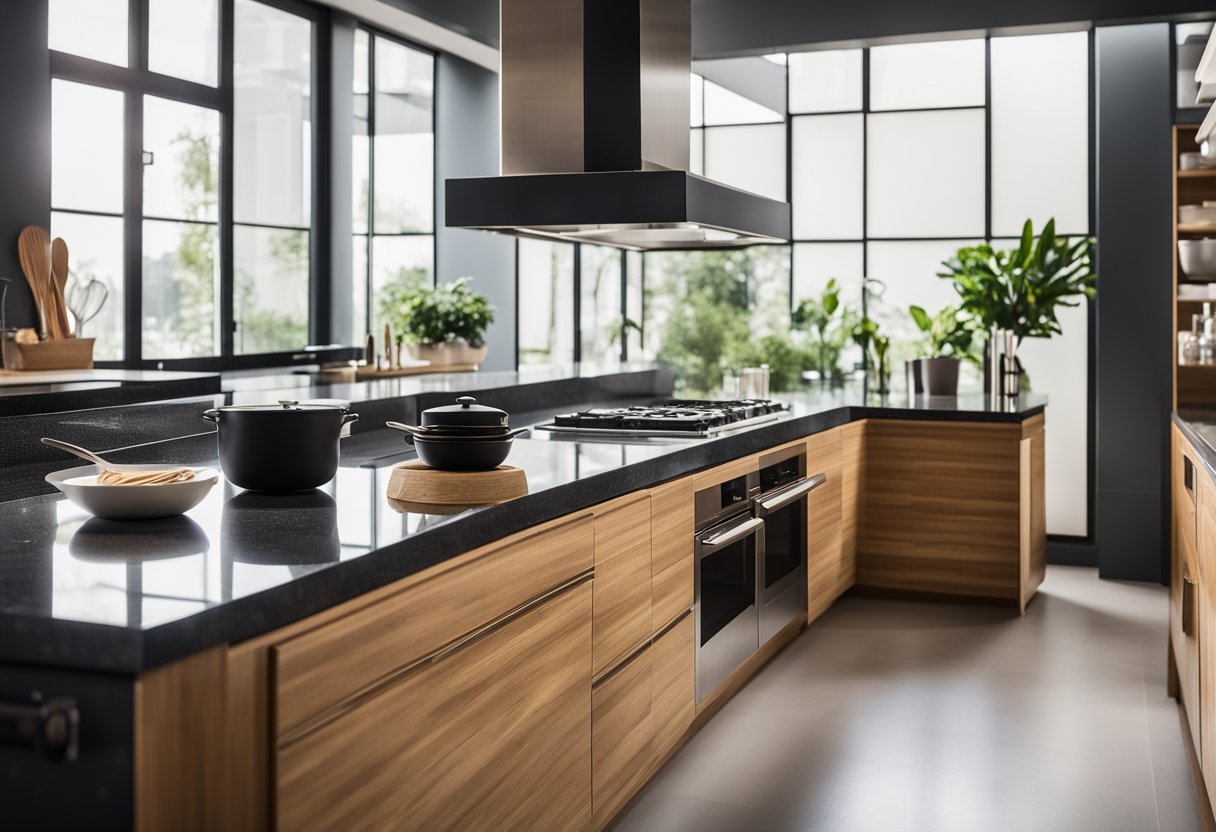
When it comes to Asian kitchen design, there are several key functional elements that contribute to creating a harmonious and efficient space. By integrating these elements, you can achieve a kitchen that not only looks beautiful but also serves as a practical and functional area for cooking and gathering.
Layouts and Space Optimisation
In Asian kitchen design, the layout plays a crucial role in optimising the available space. Whether it’s a galley kitchen, L-shaped layout, or a Japanese-inspired design, the focus is on creating a seamless flow that allows for easy movement and accessibility. By incorporating sleek and understated elements, such as frameless cabinets and clean lines, you can maximise the functionality of the kitchen while maintaining an uncluttered and inviting atmosphere.
Storage Solutions and Cabinetry
Efficient storage solutions and well-thought-out cabinetry are essential in Asian kitchen design. Utilising materials such as wood, bamboo, and glass, along with shaker-style cabinets, can bring a sense of natural elegance to the space. Incorporating elements like shoji screens and exposed beams can add an authentic touch, while providing practical storage and organisation for your kitchen essentials.
Decorative Details and Accessories
Incorporating decorative details and accessories in an Asian kitchen design can enhance the overall aesthetic while maintaining functionality. Natural stone countertops, sleek and understated furniture, and a neutral colour palette can create a calming and inviting atmosphere. Additionally, integrating elements such as a peninsula or an island can provide additional workspace and storage, adding both practicality and visual appeal to the kitchen.
By considering these functional elements and integrating them into your Asian kitchen design, you can create a space that is not only visually stunning but also highly practical and efficient.
Frequently Asked Questions
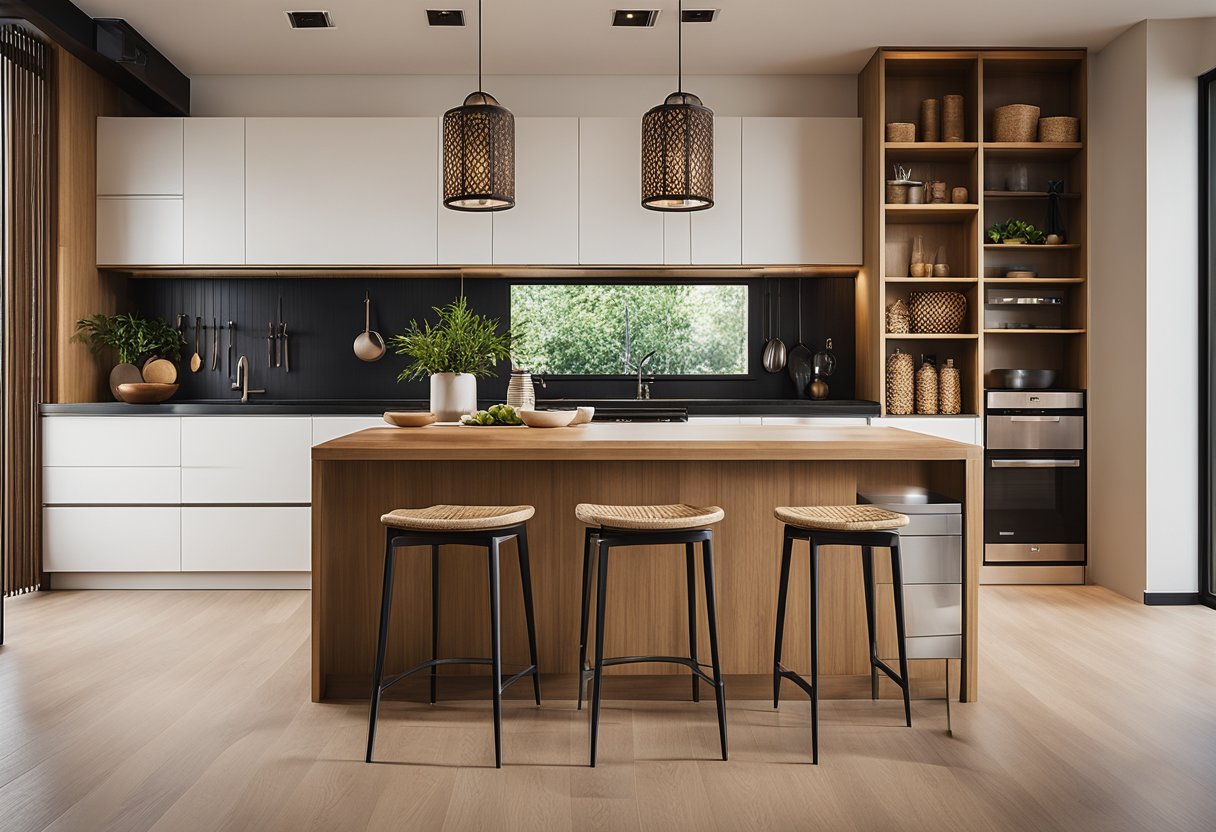
How can I infuse traditional Chinese elements into my kitchen design?
To infuse traditional Chinese elements into your kitchen design, consider adding decorative items such as Chinese porcelain, bamboo blinds, or a Chinese-inspired wallpaper. You can also incorporate traditional Chinese colours such as red, gold, and black into your kitchen design. Another way to infuse Chinese elements is by using Chinese-style cabinetry with intricate carvings and hardware.
What are the latest trends in modern Asian kitchen layouts?
The latest trends in modern Asian kitchen layouts include open-concept designs, minimalistic cabinetry, and the use of natural materials such as wood, stone, and bamboo. Another trend is the integration of smart technology into the kitchen, such as voice-activated appliances and touchless faucets.
How do I maximise space in a compact Asian-style kitchen?
To maximise space in a compact Asian-style kitchen, consider using multi-functional furniture such as a kitchen island that doubles as a dining table or storage space. You can also use wall-mounted cabinets to free up floor space and install pull-out shelves in your cabinets to maximise storage. Additionally, consider using light colours and reflective surfaces to make the space appear larger.
Which features are essential for an Asian kitchen with an island?
An Asian kitchen with an island should have a functional and spacious countertop for food preparation and cooking. The island can also have a built-in sink or stove for added convenience. Additionally, consider adding a seating area to the island for casual dining or entertaining guests.
What are the best colour schemes for Asian kitchen cabinets?
The best colour schemes for Asian kitchen cabinets include warm and earthy tones such as beige, brown, and olive green. You can also use bold colours such as red and black for a dramatic effect. Another option is to use a combination of light and dark colours to create contrast and depth.
How can I apply feng shui principles to my kitchen’s layout for optimal flow?
To apply feng shui principles to your kitchen’s layout, start by decluttering and organising your space. Ensure that your kitchen is well-lit and ventilated, and that the stove is not placed directly opposite the sink or refrigerator. You can also use feng shui colours such as green and brown to create a calming and harmonious atmosphere. Finally, consider adding natural elements such as plants or a water feature to enhance the flow of energy in your kitchen.

